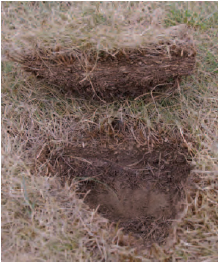Organic matter levels
Content
Most topsoil contains between 2 per cent and 5 per cent of organic matter, whereas subsoil usually contains less than 2 per cent. The distribution of organic matter under grass in normal temperate areas is shown in Figure 18.5. The organic matter is concentrated in the topsoil because most of the roots occur in this zone and the plant residues tend to be added to the surface, forming the leaf litter layer. The organic matter level in any part of the soil depends upon how much fresh material is added compared with the rate of decomposition. It is stable when these two processes are balanced and the equilibrium reached is determined mainly by climate, soil type and treatment under cultivation. Climate Climate affects both the amount of organic matter added and the rate of decomposition. Below 6°C there is no microbial activity, but it increases with increasing temperature so long as conditions are otherwise favourable. In dry areas there is not only less plant growth, resulting in less organic matter being added to the soil, but also less microbial action. In warm climates, where there is adequate moisture, low organic matter results from very much increased decomposition. In cooler areas there tends to be an accumulation of organic matter because the decreased plant growth is more than offset by the reduced micro-organism activity that occurs over the long winter periods. Organic matter also tends to accumulate in wetter conditions. Where waterlogging is prevalent, 10–20 per cent organic matter levels develop; where waterlogging is permanent organic matter accumulates to give rise to peat. Soil type Generally, soils with higher clay contents have higher organic matter levels. Coarse sands and sandy loams tend to be warmer than finer textured soils and have better aeration, which results in higher microbial activity. Such soils often support less plant growth because of poor fertility and poor water holding capacity. These factors combine to give soils with low organic matter levels. In cultivation these same soils become a problem unless large quantities of organic matter are applied at frequent intervals to maintain adequate humus levels. Such soils are often referred to as ‘hungry soils’ because of their high demand for manure. On finer-textured soils the higher fine sand, silt or clay content increases water holding capacity. This reduces soil temperature, resulting in less microbial activity. The presence of clay directly reduces the rate of decomposition because it combines with humus and protects it from microbial attack.
Cultivation Once soil has been cultivated a distinct boundary between topsoil and subsoil is developed as the concentration of organic matter in the surface layers is evened out (see Figures 18.5 and 17.5). On first cultivation the increased aeration and nutrients stimulate micro-organisms and a new equilibrium with lower soil organic matter levels prevails. Once under cultivation grasses and high-producing legumes tend to increase organic matter levels, but most crops, particularly those in which complete plant removal occurs, lead to decreased levels. Only large, regular dressings of bulky organic matter such as compost, straw, farmyard manure or leaf mould can improve or maintain the level of soil organic matter on cultivated soils. Organic matter can accumulate under grass and form a mat on the surface where the carbon cycle is slowed because of nutrient deficiency usually induced by surface soil acidity or excess phosphate levels. This is part of the reason for the development of ‘thatch’ in turf (see Figure 18.6). |






